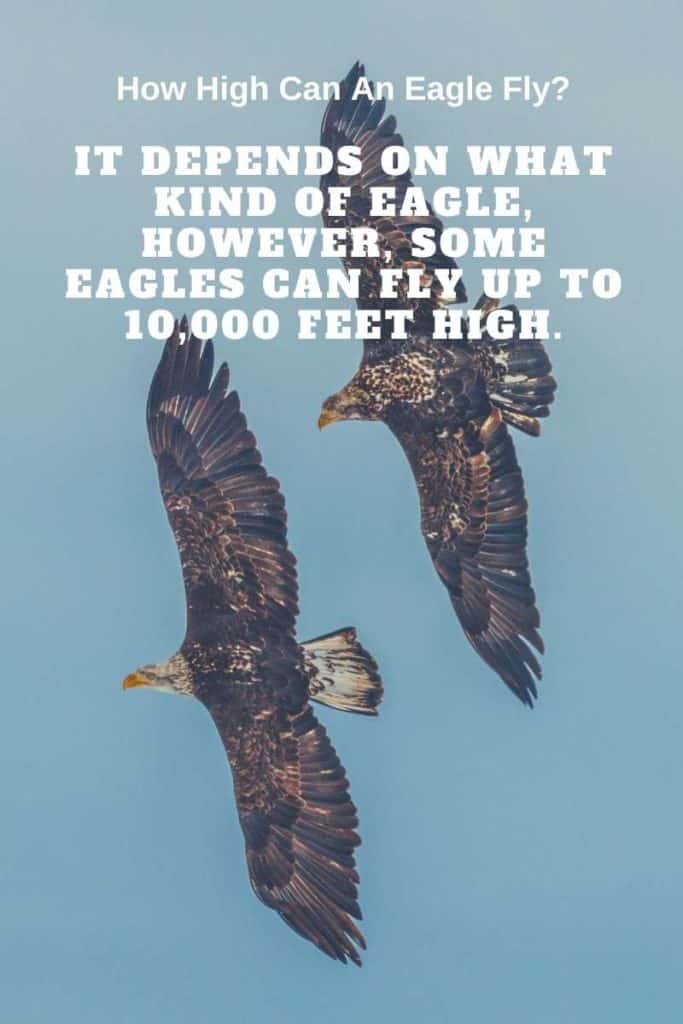The majestic eagle is not only a symbol of freedom but also an incredible aviator. From questions like how fast they can fly to the height that they reach, it’s no wonder why this bird has been such a fixture in American culture for centuries. Let’s dive into some more details and find out what makes these magnificent birds so special!
Table of Contents

How fast can eagles fly?
Eagles can be majestic and quite terrifying in their hunting mode. They have the capability of using incredible momentum to divebomb unsuspecting prey at speeds up to 75-100 MPH (120-160 km/h)!
The fastest recorded speed was from a golden eagle, which was officially documented as flying at 80 miles per hour (128 km/h) while diving for its prey.
The average speed is 35 to 40 mph, though eagles can also fly slowly if they are searching for food or soaring on rising air currents.
Eagles often only flap their wings when they are trying to land. Most of the time they just let them hang down behind them and use wind currents to help carry them along. Some species of eagles even sleep with their wings spread out like a fan in order to be more streamlined.
How high can eagles fly?
It depends on what kind of eagle, however, some eagles can fly up to 10,000 feet high. Other kinds of eagles prefer to stay closer to the ground where they can easily spot prey or catch thermals to help them fly more efficiently. Bald and golden eagles usually live near lakes or oceans as it is an easy place for them to find fish.
In order to reach this enormous height, they need to utilize a very wide wingspan. The golden eagle has the longest wingspan of any eagle. It measures about 6.5 feet from tip to tip and is almost as big as a grown man! That means when they are flapping their wings, they can cover a lot of distance or height.
The majestic eagle is not only a symbol of freedom but also an incredible aviator. From questions like how fast they can fly to the height that they reach, it’s no wonder why this bird has been such a fixture in American culture for centuries. Let’s dive into some more details and find out what makes these magnificent birds so special!

How can eagles breathe at such high altitudes?
Flying sucks ten- to twenty times more oxygen than resting. Flying birds gulp air, deriving oxygen to fuel their hard-working muscles but this critical element is in short supply at high elevations with only one-third of the amount available that we have on earth’s surface. Such a low elevation has been coined as hypoxia by scientists and it poses great risks for all flyers including people who fly planes or work in an environment where they are constantly traveling up mountains like mountain climbers, hikers or mountaineers.
In addition, the birds have to battle freezing nighttime temperatures while flying high above the mountains. Perhaps they can find cool pockets of air that would be more welcoming than warm afternoon conditions and provide them with a better opportunity for survival in cold environments.
Eagles have a suite of special features that other, ‘low-level’ birds do not have, such as large lungs, a dense network of blood vessels in the wing muscles, hemoglobin in their blood that adheres to oxygen. They can hyperventilate at seven times the normal resting rate without passing out and possess more mitochondria, the energy production centers within cells. All these physiological features allow them to extract the most mileage from every breath of oxygen and fly at high altitudes.
They can also extract up to 90% of the oxygen from air. This ability goes up as the air becomes more hypoxic. Eagles have a method in order to increase the volume of blood: They either increase their heart rate or push more blood out with every heartbeat. Both ways get oxygen from the lungs to body tissues. These are significant adaptations that make perfect sense.
See here an interesting list of birds by flight heights.
RichardAlois recommends…
- Main Stone: 1 Oval Buff Top Cut Genuine Black Onyx, 16 mm x 12 mm
- Sterling Silver; Contains 12.80 grams of Sterling Silver
- Measures: 13 mm wide x 18.5 mm long x 5.5 mm high; Shank Width: 7.5 mm wide
- The noble eagle is the very image of freedom and beauty
- This stunning statue is meticulously crafted of polyresin and can be proudly displayed in your home
- Comes with a wooden base and felt pads on the bottom to protect the surface
What are the top 10 unique facts about eagles?
- Eagles are part of an order of birds known as raptors, meaning they hunt for food in a predatory manner.
- The bald eagle is unique among raptor species because it’s considered a neotenic species that doesn’t undergo a full maturation process like most other birds. (Source)
- Eagles can see up to four times farther than humans and eagles eyesight is eight times better than human sight at spotting fish below water surface; they also boast near perfect vision during low light conditions as well!
- Eagles are capable of flying at speeds up to 100 mph and can reach heights of 10,000 feet in the air.
- A bald eagle’s wingspan measures around seven feet wide
- Bald eagles are known to live an average of 30 years in the wild.
- In some parts of the world, it’s illegal for an eagle to be killed or captured alive unless it was a case of self-defense.
- When hunting for food, the bald eagle can reach speeds of up to 60 mph!
- According to Guinness World Records, the tallest flight by a bird was achieved on November 3, 2009 by a Rüppell’s griffon vulture named Graf Zahl who flew 11,407 meters high.
- The American Bald Eagle’s average flight speed varies between 30 mph – 50 mph if they are flying in pursuit of prey but eagles have been able to soar at top speeds of 100 mph during migration or when searching for food.
Great eagle flight recorded
Conclusion
Eagles are powerful creatures that have adapted to fly at high altitudes and in cold temperatures. With a few special features, eagles can breathe oxygen-rich air from the sky with less effort than other birds. One of these adaptations is their large lungs which allow them to extract more oxygen out of each breath they take without passing out. Eagles also possess an increased number of mitochondria within cells which provides them energy when they need it most – during flight time!
In another post, we also compared the owl vs eagle.
[Video] These Are 10 Highest Flying Birds Ever
FAQ
How high can an eagle fly?
It depends on what kind of eagle, however, some eagles can fly up to 10,000 feet high. Other kinds of eagles prefer to stay closer to the ground where they can easily spot prey or catch thermals to help them fly more efficiently. Bald and golden eagles usually live near lakes or oceans as it is an easy place for them to find fish.
How high can an eagle fly in meters?
It depends on what kind of eagle, however, some eagles can fly up to 10,000 feet high. That is in meters around 3000 meters high.
How fast and high can an eagle fly?
Eagles can be majestic and quite terrifying in their hunting mode. They have the capability of using incredible momentum to divebomb unsuspecting prey at speeds up to 75-100 MPH (120-160 km/h)!





